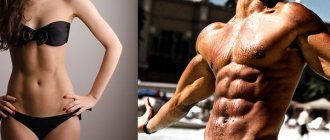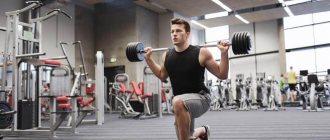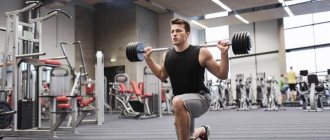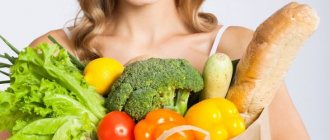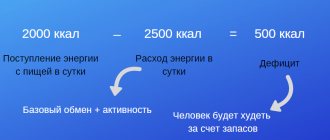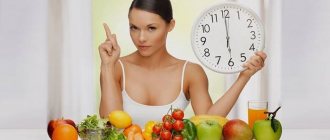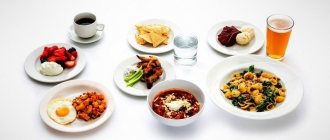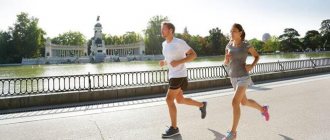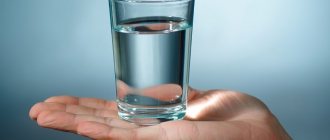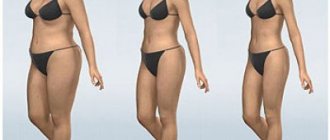Guessing and assumptions will not help you create an effective fat-burning diet. Listen to expert Christine Hronek's advice on how to create your own cutting diet.
If you have recently decided to get rid of excess fat, then you have probably thought a lot about it, and are expecting immediate results.
Now that you've gathered your courage, you expect to see consistent, visible results that you can track weekly.
In reality, losing weight and burning fat are two different things. Kilograms can be lost due to a decrease in the volume of water, glycogen, muscle or fat.
There are too many nutrition programs for weight loss floating around the Internet, often calling for creating a calorie deficit, which prevents the preservation of muscle mass and leads to metabolic disorders in the long term.
To ensure that fat loss does not harm lean muscle, it is necessary to design a body-cutting diet based on sound scientific principles.
This article was written to teach you how to build a step-by-step nutrition plan to reduce the percentage of body fat without losing muscle mass, and how to properly create and follow a daily diet.
Nutrition for drying the body: menu for men
The main difficulty here is maintaining balance. That is, you should not eat as if you were gaining weight, but you should not starve either. Malnutrition will certainly have a negative impact either on the athlete’s condition, or on the visual result, on the quality of the body.
By constantly eating incorrectly, an athlete loses muscle tissue along with fat, and cutting does not pursue such a goal. Weakness, loss of strength, and depression begin. Internal organs deteriorate.
Such consequences are often irreversible, therefore: think carefully about your diet . The body drying menu for men should be balanced and the amount of food sufficient for an athlete!
Cutting diets are different from many other diets. Here it is important to minimize slow carbohydrates and eliminate fast ones completely. Moreover, an athlete’s diet is different on different days: on the day of training, you can consume a little carbohydrates, and on days when there are no training, you can completely ignore them (carbohydrates).
- Exclude from your diet : sweets, baked goods, semi-finished products, canned food, butter, pork, chicken with skin, fatty cheese, pork, lamb, goose, alcohol, fast food. Minimize salt, oil and seasonings.
- Include in your diet : lean meat, preferably chicken, veal, rabbit and turkey, greens, legumes, low-fat dairy and fermented milk products, fruits (except bananas), vegetables (except potatoes), sea fish and seafood, fiber, nuts in small quantities.
- If you eat carbohydrates, be sure to have a low glycemic index (porridge, non-starchy vegetables). Allowed: brown bread, cereals, pasta and fruits and vegetables. You will definitely need a table of calorie content of porridges, keep it for yourself.
A cutting menu for men is not complete without protein bars and cocktails - during this period the athlete needs 1/3 more protein than during the period of strength development (up to 2 - 2.5 grams per kilogram of weight). If this amount cannot be obtained from food, sports nutrition comes to the rescue. It is also advisable to take multivitamin complexes.
During drying, we reduce carbohydrates Fats - no more than 0.5 per 1 kilogram, but they must be consumed. Calorie counting is secondary; a competent balance of nutritional supplements is much more important.
Example of a cutting diet
It should be noted that there is no universal diet!
Our bodies are very different. And although there are general patterns in nutrition, each person’s reaction to the same product is individual.
Sample menu for drying the body for a man weighing 100 kg:
- Breakfast
- a bowl of oatmeal (wild rice or buckwheat)
- 10 egg whites and 2 yolks
- tea/coffee without sugar and cream
- Lunch
- apples - 1-2 pieces (fruits in season)
- cottage cheese - 200 grams
- Dinner
- chicken fillet - 300 grams
- vegetable salad
- 1-2 slices of black bread
- Afternoon snack
- protein shake with water - 2 servings
- or 0.5-1 liter of kefir
- Dinner
- Baked hake – 300 grams + vegetables
Total caloric content - about 3000 kcal:
- Protein – 200-250 grams
- Fats – 50 grams
- Carbohydrates – 300-350 grams
Nutrition during drying has one general pattern:
In the first half of the day, the bulk of the daily carbohydrate intake is consumed, and in the afternoon the emphasis is on protein foods and vegetables.
Much attention is also paid to the form of food preparation. Products can be boiled, stewed or baked. Frying is prohibited.
Proper drying: how to safely reduce the amount of carbohydrates?
The main reduction in calorie content during drying should be achieved by eliminating simple carbohydrates and fats of animal origin. You need to reduce your caloric intake gradually; for starters, it is enough to reduce it by 10%. After the innovation, wait a week and analyze the situation. If doing workouts does not bring discomfort in the form of fatigue and lack of energy, and the weight on the scale does not change, you can cut calories by another 10%.
Don't forget about proper training. While cutting, excessive cardio exercise is not recommended, which, in addition to weight, can reduce muscle mass. For this reason, the basis of training is anaerobic exercise, which promotes fat burning and does not have a negative effect on muscle mass. If you are used to running every morning, replace the habit with regular walking. This way you will start the fat burning process without affecting the quality of your muscles.
It is important! For men and women, training programs and their intensity are different. To clarify the optimal level of physical activity, consult a specialist.
Basic principles of nutrition on a diet for cutting
Diet, in the correct understanding of the word, first of all means adherence to a diet , but not fasting, with which diet is associated with most people.
Small meals 5-6 times a day
It is very important not to overdo it with calories, with 6 meals a day. Therefore, you must prepare your own food for the whole day (in the morning or evening the next day), weighing the food and observing the required caloric intake.
Use the calculator to calculate the number of calories you need. Select raw foods (later I will discuss the correct selection and ratio of proteins, fats and carbohydrates) and cook them. And divide into six parts. Most of the food you eat (calories) should come from your morning and post-workout meals.
In daily percentage terms, carbohydrates should account for 50-60% of calories, proteins 30-40, and fats 10-20.
Consume at least 2 grams of protein per 1 kg. body weight. Carbohydrates 2-3 grams per 1 kg. You need to eat every 2-3 hours. Not eating after 6 pm is wrong. It is correct not to eat carbohydrates after 18-00, but to consume proteins. It is correct not to eat 2 hours before bedtime. (For extreme fat burning, do not consume carbohydrates after 2 p.m.).
Below, I will give an example of my diet at the initial stage of drying, taking into account daily calorie content and my diet. (You can adjust it to suit your regime)
Rise 4:45
- 5-00 - take a portion of protein - 23 g. protein - 120 kcal
- 5-30 - 100 gr. oatmeal (any whole grain porridge) with milk 0.5% 400 ml. half a scoop of protein in oatmeal + 100 grams of breast (grilled fish) 667 kcal 25 gr. protein about 90 grams of carbohydrates.
- 7-30 - 100 gr. buckwheat (pasta, rice,) 100 grams of grilled breast - 70 grams of coals - 20 grams of protein - 430 kcal
- 8-40 - portion of BCA
- 9-00 - high-intensity training 40 min + 20 min cardio - protein immediately after training - 120 kcal , 23 g. squirrel
- 10 -00 - 100 gr. buckwheat (pasta, rice,) 100 grams of grilled breast - 70 grams of coals - 20 grams of protein 430 kcal
- 13-00 - 100 gr. buckwheat (pasta, rice,) 100 grams of grilled breast - 70 grams of coals - 20 grams of protein 430 kcal
- 16-00 - 200 grams of fish, (breast), - about 40 grams of protein 226 kcal + vegetables
- 19-00 - 150 grams of low-fat cottage cheese - 25 gr. protein 122 kcal
- 22-00 Portion of BCA - Lights out
Total for the day 2545 kcal . Approximate deficit of 300 kcal + additional consumption during training. Protein - about 200 grams, carbohydrates 300 grams.
In the future, as my fat reserves decrease, I will cut down on carbohydrates, bringing it to 100 grams per day at the end of the cut.
Drink plenty of water, at least 2-3 liters when drying
If you do not drink enough water (clean water) you will not be able to maintain metabolic processes at a high level. Your fat burning process will slow down or stop altogether.
Remove “fast” carbohydrates from your diet
“Fast” or simple carbohydrates are foods that quickly increase blood sugar (glucose) levels.
A sharp rise in blood sugar causes a sharp release of insulin, a transport hormone that is responsible for supplying energy for current needs to the organs.
Insulin transports excess energy (glucose) directly to the “fat depot”. In addition, a sharp release of insulin blocks the breakdown of fats in your body.
I can’t help but mention the Glycemic Index of foods (GI) - a value designed to reflect the rate at which a particular product in your body is broken down into glucose. The standard for this value is glucose, whose index is 100.
Basically, all simple carbohydrates have a high GI. The higher the GI, the faster the food will raise your sugar levels, the more powerful the insulin release, the more glucose will be converted into fat and the faster you will feel hungry.
You can find tables with GI products on the Internet. Try to eat foods with an average GI. If a product has a low GI, but high calorie content, then such a product should not be consumed.
Taking a medium or high GI food with protein reduces the overall GI.
Taking a product with fiber (raw vegetables, bran, whole grain bread) reduces the overall GI.
Therefore, you need to exclude from your diet:
- Sugar (in general), if it is difficult to eliminate it altogether, then use a sweetener
- Flour products: white bread, pizza rolls, pasta not made from durum wheat, etc.
- Confectionery
- Alcohol including beer
- Sweet sodas and juices
- Potato
- Sweet fruits
- Semi-finished products, ready-made food from the supermarket
- Sauces, mayonnaise (Except Soy)
Use only complex (slow) carbohydrates on your diet
Whole grain cereals, durum wheat pasta, whole grain bread - products, raw vegetables.
These foods slowly raise blood glucose levels without triggering insulin spikes, allowing you to feel fuller longer while reducing fat storage.
Avoiding cooking food by frying in oil
During the frying process, carcinogenic substances are formed in the oil, which is extremely unhealthy for the long term.
In addition, the use of oil increases the calorie content of the dish. There is a good chance that you will go overboard on calories when cooking this way.
Recommendation:
Cook foods in the oven by baking them, or by boiling them, or by steaming them using a slow cooker. If you don’t already have a multicooker, I highly recommend purchasing this extremely useful tool for preparing healthy food. In addition, a multicooker saves your time a lot.
Another extremely useful tool for preparing healthy food is a kitchen grill. I recommend purchasing it if you have the financial opportunity. As a last resort, use a special spray for frying foods. It contains virtually no calories and you'll cook great, low-calorie meals in the skillet too.
What foods contain complex carbohydrates?
As mentioned above, complex carbohydrates must be present during drying. They are found in many foods: vegetables, fruits, cereals. Nutritionists say that foods need to be chosen correctly to prevent the deposition of fat reserves.
- Vegetables. To avoid problems with the gastrointestinal tract, you need to choose slow carbohydrates with a high fiber content. These include cucumbers, potatoes, pumpkin, and zucchini.
- Fruits. When choosing them, you should be careful and choose those that contain the least amount of sugars. Preference should be given to apples, pears and pomegranates. Occasionally you can eat black currants, figs and blackberries.
- Cereals and legumes. This category of food products is characterized by a high content of beneficial vitamins and microelements. When drying, it is recommended to eat buckwheat, rye, oats, and brown wild rice.
- Porridge. Almost all cereals are complex carbohydrates, with the exception of semolina. When drying, you can cook porridge with water or skim milk.
- Pasta. You can eat it 3 times a week, provided that the product is made from wholemeal flour.
If you have an avid sweet tooth and it is very difficult to give up sweets, occasionally for breakfast you can eat a piece of dark chocolate or homemade jelly based on berries or fruits.
Reference! You can calculate proteins, fats and carbohydrates for cutting using an online calculator.
